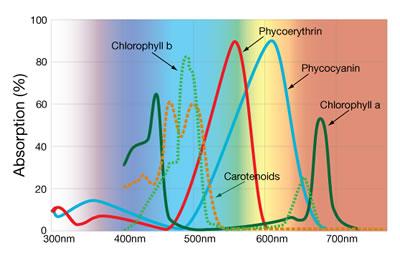Photosynthetic Active Radiation (PAR)

What it is, and Why it Matters
Photosynthetically Active Radiation (PAR) refers to one way of measuring the range of light wavelengths (400–700 nanometers [nm]) that can be used for photosynthesis (see absorption range for photosynthesis chart above). This range covers the visible spectrum of light, which includes red (700–635 nm), orange (635–590 nm), yellow (590–560 nm), green (560–490 nm), blue (490–450 nm), and violet (450–400 nm) wavelengths. Plants obtain the most light energy from the red, blue, and violet portions of the spectrum because these wavelengths are the most readily absorbed by chlorophyll, the main pigment in plants. In order to determine whether plants are receiving the correct spectrum for efficient photosynthesis, it is important to measure the PAR value of the light being used. Typically, a higher PAR value equals increased growth and healthier plants. PAR can be expressed in energy units, as watts per square meter (wm-2), or in quantum units, as micromoles of quanta per second per square meter (µmol s-1 m-2).

As noted above, PAR is one way of measuring light that places more importance on specific wavelengths that are useful in powering photosynthesis. Another common but less accurate measurement of the quality of light put out by a light source is luminous flux, given in units of lumens or lux. We address lumens and why they aren’t relevant when assessing the quality of a light source for growing plants in the article found here. This means that two lights can have the same lumen rating but one could have a significantly higher PAR rating if it uses more of the wavelengths used during the process of photosynthesis.
At Black Dog LED we use a Spectroradiometer to test all of our lights -as well as others on the market- to ensure that we continue to deliver the most powerful lights available for growing plants.
While PAR is useful, it isn't a perfect measure of how a grow light will perform. Click here to visit our FAQ and learn more.
If you are interested in learning more about photosynthesis click here.






